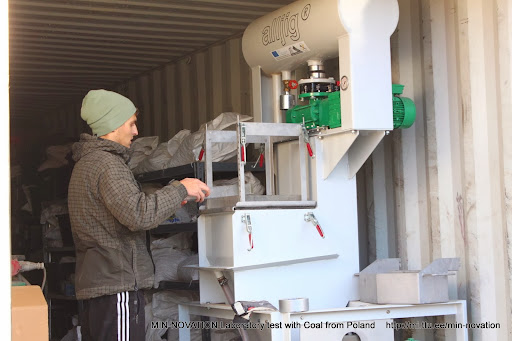Pilot Unit for Mining Waste Reduction Methods
Veiko Karu 1 , Tiit Rahe 2 , Erki Närep 3 , Vivika Väizene 4 , Juan da Costa 5
1-5 Tallinn University of Technology
DOI: doi: 10.7250/iscect.2013.008
Pilot unit test: Coal Waste from Poland
Estonia pilot unit: "Waste to product"
Test: Coal waste from Poland
Pilot unit: crushing bucket and wheel loader

Coal Waste from Poland

Preparations for taking samples for sieving

Sample for sieving test

Coal waste before crushing

Crushing with crushing bucket. Result: particle size 0 to 40 mm

Coal Waste after crushing

Analyzing parameters

Analyzing parameters

Sample from crushed coal waste


Preparations for separation process


Separation process

Befor separation

After separation

After separtion process: upper layer "Coal"

After separation process: lower layer "waste rock"

--
MIN-NOVATION Mining and Mineral Processing Waste Management Innovation Network
http://mi.ttu.ee/min-novation/
SDIMI 2013 presentation "Mining waste management of Estonian mineral resources" by Veiko Karu, 02.07.2013
SDIMI 2013
6th International Conference on Sustainable Development in the Minerals Industry
30 June - 3 July 2013, Milos island, Greece
Session: Sustainable Energy and Land Use
"Mining waste management of Estonian mineral resources" by Veiko Karu
Presentation:
| From SDIMI 2013, Milos, Greece |
| From SDIMI 2013, Milos, Greece |
This research was supported by European Social Fund’s Doctoral Studies and Internationalisation Programme DoRa, which is carried out by Foundation Archimedes. - See more at: http://adm.archimedes.ee/stipendiumid/programm-dora/avalikkuse-teavitamine/#sthash.niCKfSKv.dpuf
Possibilities of fine material removal
Summary of bachelor study on "Possibilities of fine material removal". Author: Erki Närep
Limestone is one of the most common minerals in Estonia. It is mainly used as raw material for the production of splinters and cement. The limestone bed consists of upper layers with high quality limestone and lower layers with clay-rich limestone. Producing splinters and cement with a clay-rich limestone requires additional processing, in order to reduce clay content using fine material removal.
Limestone is one of the most common minerals in Estonia. It is mainly used as raw material for the production of splinters and cement. The limestone bed consists of upper layers with high quality limestone and lower layers with clay-rich limestone. Producing splinters and cement with a clay-rich limestone requires additional processing, in order to reduce clay content using fine material removal.
The aim of this study was to test
and evaluate three different methods for fine material removal – jigging,
pressure washing and dry sieving, and research the appropriate equipment. As a
reference method, washing by hand was also carried out which represented the
ideal subsample. In this study, fine material is defined as material sized
0-4 mm. The clay-rich limestone sample material used in the experimental
work was taken from Väo IV open cast. The sample material was first homogenized
and distributed into subsamples. The subsamples were then processed using the
mentioned methods. Finally, sieve analysis was carried out with the processed
subsamples in order to evaluate the effectiveness of these methods.
The results showed that the most
effective method is dry sieving, which removed the full percentage of fine
material. Jigging removed 70% and pressure washing removed 29% of the 0-4 mm
sized material. The appropriate equipment for fine material removal is
McLanahan’s Rotary Scrubber, McLanahan’s Log Washer and Haver & Boecker’s
Hydro Clean Washing System.
- Extraction with hydraulic hammer
- Preliminary crushing with jaw crusher
- Fine material removal with Hydro Clean Washing System
- Producing splinters with a crusing complex
- Processing removed fine material with CDE equipment
International conference "Mining Waste Management in Estonia", 16.05.2013
1. “Mineral Resources of Estonia”, Tarmo All, Ministry of Environment
2. “Mining Waste challenges in Sweden”, Stefan Sädbom
3. “Financing for mining waste management activities in Estonia“, Kati Nikopensius, Startup Incubator Tehnopol
4. "National Energytechnology Programme a way to sustainable economy", Jaanus Sahk, National Energytechnology Programme
5. “About MIN-NOVATION project”, Anna Ostrega, AGH
6. “Waste Management challenges in Estonia” Ulvi-Karmen Mõller, Ministry of Environment
7. “Cement production and waste management”, Riho Iskül, Kunda Nordic Cement, Heidelberg Group
8. “Oil Shale Competence Center”, Kalle Pirk, Oil Shale Competence Center, TUT
9. “Role of Environmental Board in Mineral Extraktion”, Tiit Kaasik, Environmental Board
2. “Mining Waste challenges in Sweden”, Stefan Sädbom
3. “Financing for mining waste management activities in Estonia“, Kati Nikopensius, Startup Incubator Tehnopol
4. "National Energytechnology Programme a way to sustainable economy", Jaanus Sahk, National Energytechnology Programme
5. “About MIN-NOVATION project”, Anna Ostrega, AGH
6. “Waste Management challenges in Estonia” Ulvi-Karmen Mõller, Ministry of Environment
7. “Cement production and waste management”, Riho Iskül, Kunda Nordic Cement, Heidelberg Group
8. “Oil Shale Competence Center”, Kalle Pirk, Oil Shale Competence Center, TUT
9. “Role of Environmental Board in Mineral Extraktion”, Tiit Kaasik, Environmental Board
www.ttu.ee/min-novation
UTILIZATION OF WASTE ROCK FROM OIL SHALE MINING
Estonian Academy Publishers:
UTILIZATION OF WASTE ROCK FROM OIL SHALE MINING; pp. 321–330 | ||||||||||
| ||||||||||
Subscribe to:
Comments (Atom)
